|
A* Pathfinding Project
3.8.5
The A* Pathfinding Project for Unity 3D
|
|
A* Pathfinding Project
3.8.5
The A* Pathfinding Project for Unity 3D
|
Automatically generates navmesh graphs based on world geometry. More...
Automatically generates navmesh graphs based on world geometry.
The recast graph is based on Recast (http://code.google.com/p/recastnavigation/).
I have translated a good portion of it to C# to run it natively in Unity. The Recast process is described as follows:
It works exactly like that in the C# version as well, except that everything is triangulated to triangles instead of n-gons. The recast generation process usually works directly on the visiable geometry in the world, this is usually a good thing, because world geometry is usually more detailed than the colliders. You can however specify that colliders should be rasterized, if you have very detailed world geometry, this can speed up the scan.
Check out the second part of the Get Started Tutorial which discusses recast graphs.
In the editor there is a button for exporting the generated graph to a .obj file. Usually the generation process is good enough for the game directly, but in some cases you might want to edit some minor details. So you can export the graph to a .obj file, open it in your favourite 3D application, edit it, and export it to a mesh which Unity can import. You can then use that mesh in a navmesh graph.
Since many 3D modelling programs use different axis systems (unity uses X=right, Y=up, Z=forward), it can be a bit tricky to get the rotation and scaling right. For blender for example, what you have to do is to first import the mesh using the .obj importer. Don't change anything related to axes in the settings. Then select the mesh, open the transform tab (usually the thin toolbar to the right of the 3D view) and set Scale -> Z to -1. If you transform it using the S (scale) hotkey, it seems to set both Z and Y to -1 for some reason. Then make the edits you need and export it as an .obj file to somewhere in the Unity project. But this time, edit the setting named "Forward" to "Z forward" (not -Z as it is per default).


Classes | |
| class | NavmeshTile |
Public Types | |
| enum | RelevantGraphSurfaceMode { DoNotRequire, OnlyForCompletelyInsideTile, RequireForAll } |
Public Member Functions | |
| Vector3 | ClosestPointOnNode (TriangleMeshNode node, Vector3 pos) |
| Returns the closest point of the node. | |
| bool | ContainsPoint (TriangleMeshNode node, Vector3 pos) |
| Returns if the point is inside the node in XZ space. | |
| override void | DeserializeExtraInfo (GraphSerializationContext ctx) |
| Deserializes graph type specific node data. | |
| override void | DeserializeSettingsCompatibility (GraphSerializationContext ctx) |
| An old format for serializing settings. | |
| void | EndBatchTileUpdate () |
| End batch updating of tiles. | |
| override NNInfoInternal | GetNearest (Vector3 position, NNConstraint constraint, GraphNode hint) |
| Returns the nearest node to a position using the specified NNConstraint. | |
| override NNInfoInternal | GetNearestForce (Vector3 position, NNConstraint constraint) |
| Returns the nearest node to a position using the specified constraint . | |
| override void | GetNodes (GraphNodeDelegateCancelable del) |
| Calls a delegate with all nodes in the graph. | |
| NavmeshTile | GetTile (int x, int z) |
| Tile at the specified x, z coordinate pair. | |
| Bounds | GetTileBounds (IntRect rect) |
| Returns an XZ bounds object with the bounds of a group of tiles. | |
| Bounds | GetTileBounds (int x, int z, int width=1, int depth=1) |
| Returns an XZ bounds object with the bounds of a group of tiles. | |
| void | GetTileCoordinates (int tileIndex, out int x, out int z) |
| Returns tile coordinates from a tile index. | |
| Int2 | GetTileCoordinates (Vector3 p) |
| Returns the tile coordinate which contains the point p. | |
| int | GetTileIndex (int index) |
| Returns a tile index from a vertex index. | |
| NavmeshTile[] | GetTiles () |
| Get all tiles. | |
| IntRect | GetTouchingTiles (Bounds b) |
| Returns a rect containing the indices of all tiles touching the specified bounds. | |
| IntRect | GetTouchingTilesRound (Bounds b) |
| Returns a rect containing the indices of all tiles by rounding the specified bounds to tile borders. | |
| Int3 | GetVertex (int index) |
| Gets the vertex coordinate for the specified index. | |
| int | GetVertexArrayIndex (int index) |
| bool | Linecast (Vector3 origin, Vector3 end) |
| bool | Linecast (Vector3 origin, Vector3 end, GraphNode hint, out GraphHitInfo hit) |
| bool | Linecast (Vector3 origin, Vector3 end, GraphNode hint) |
| bool | Linecast (Vector3 tmp_origin, Vector3 tmp_end, GraphNode hint, out GraphHitInfo hit, List< GraphNode > trace) |
| Returns if there is an obstacle between origin and end on the graph. | |
| override void | OnDestroy () |
| Function for cleaning up references. | |
| override void | OnDrawGizmos (bool drawNodes) |
| Draw gizmos for the graph. | |
| GraphNode | PointOnNavmesh (Vector3 position, NNConstraint constraint) |
| Finds the first node which contains position. | |
| override void | RelocateNodes (Matrix4x4 oldMatrix, Matrix4x4 newMatrix) |
| Relocates the nodes in this graph. | |
| void | ReplaceTile (int x, int z, Int3[] verts, int[] tris, bool worldSpace) |
| Replace tile at index with nodes created from specified navmesh. | |
| void | ReplaceTile (int x, int z, int w, int d, Int3[] verts, int[] tris, bool worldSpace) |
| override IEnumerable< Progress > | ScanInternal () |
| Internal method to scan the graph. | |
| override void | SerializeExtraInfo (GraphSerializationContext ctx) |
| Serializes Node Info. | |
| void | SnapForceBoundsToScene () |
| Changes the bounds of the graph to precisely encapsulate all objects in the scene that can be included in the scanning process based on the settings. | |
| void | StartBatchTileUpdate () |
| Start batch updating of tiles. | |
 Public Member Functions inherited from NavGraph Public Member Functions inherited from NavGraph | |
| virtual void | Awake () |
| This will be called on the same time as Awake on the gameObject which the AstarPath script is attached to. | |
| virtual int | CountNodes () |
| Number of nodes in the graph. | |
| NNInfoInternal | GetNearest (Vector3 position) |
| Returns the nearest node to a position using the default NNConstraint. | |
| NNInfoInternal | GetNearest (Vector3 position, NNConstraint constraint) |
| Returns the nearest node to a position using the specified NNConstraint. | |
| virtual Color | NodeColor (GraphNode node, PathHandler data) |
| Color to use for gizmos. | |
| virtual void | PostDeserialization () |
| Called after all deserialization has been done for all graphs. | |
| void | Scan () |
| void | ScanGraph () |
| Partially scan the graph. | |
| void | SetMatrix (Matrix4x4 m) |
| Use to set both matrix and inverseMatrix at the same time. | |
 Public Member Functions inherited from INavmesh Public Member Functions inherited from INavmesh | |
| void | GetNodes (GraphNodeDelegateCancelable del) |
 Public Member Functions inherited from IRaycastableGraph Public Member Functions inherited from IRaycastableGraph | |
| bool | Linecast (Vector3 start, Vector3 end) |
| bool | Linecast (Vector3 start, Vector3 end, GraphNode hint) |
| bool | Linecast (Vector3 start, Vector3 end, GraphNode hint, out GraphHitInfo hit) |
| bool | Linecast (Vector3 start, Vector3 end, GraphNode hint, out GraphHitInfo hit, List< GraphNode > trace) |
 Public Member Functions inherited from IUpdatableGraph Public Member Functions inherited from IUpdatableGraph | |
| GraphUpdateThreading | CanUpdateAsync (GraphUpdateObject o) |
| void | UpdateArea (GraphUpdateObject o) |
| Updates an area using the specified GraphUpdateObject. | |
| void | UpdateAreaInit (GraphUpdateObject o) |
| May be called on the Unity thread before starting the update. | |
| void | UpdateAreaPost (GraphUpdateObject o) |
| May be called on the Unity thread after executing the update. | |
 Public Member Functions inherited from INavmeshHolder Public Member Functions inherited from INavmeshHolder | |
| void | GetTileCoordinates (int tileIndex, out int x, out int z) |
| Int3 | GetVertex (int i) |
| int | GetVertexArrayIndex (int index) |
Public Attributes | |
| const int | BorderVertexMask = 1 |
| const int | BorderVertexOffset = 31 |
| float | cellSize = 0.5F |
| Voxel sample size (x,z). | |
| float | characterRadius = 1.5F |
| Radius of the agent which will traverse the navmesh. | |
| float | colliderRasterizeDetail = 10 |
| Controls detail on rasterization of sphere and capsule colliders. | |
| float | contourMaxError = 2F |
| Max distance from simplified edge to real edge. | |
| bool | dynamic = true |
| Enables graph updating. | |
| int | editorTileSize = 128 |
| Size in voxels of a single tile. | |
| Vector3 | forcedBoundsCenter |
| Center of the bounding box. | |
| Vector3 | forcedBoundsSize = new Vector3(100, 40, 100) |
| Size of the bounding box. | |
| LayerMask | mask = -1 |
| Layer mask which filters which objects to include. | |
| float | maxEdgeLength = 20 |
| Longer edges will be subdivided. | |
| float | maxSlope = 30 |
| Max slope in degrees the character can traverse. | |
| float | minRegionSize = 3 |
| Minumum region size. | |
| bool | nearestSearchOnlyXZ |
| Perform nearest node searches in XZ space only. | |
| bool | rasterizeColliders |
| Use colliders to calculate the navmesh. | |
| bool | rasterizeMeshes = true |
| Use scene meshes to calculate the navmesh. | |
| bool | rasterizeTerrain = true |
| Include the Terrain in the scene. | |
| bool | rasterizeTrees = true |
| Rasterize tree colliders on terrains. | |
| RelevantGraphSurfaceMode | relevantGraphSurfaceMode = RelevantGraphSurfaceMode.DoNotRequire |
| Require every region to have a RelevantGraphSurface component inside it. | |
| bool | scanEmptyGraph |
| If true, scanning the graph will yield a completely empty graph. | |
| bool | showMeshOutline = true |
| Show an outline of the polygons in the Unity Editor. | |
| bool | showMeshSurface |
| Show the surface of the navmesh. | |
| bool | showNodeConnections |
| Show the connections between the polygons in the Unity Editor. | |
| List< string > | tagMask = new List<string>() |
| Objects tagged with any of these tags will be rasterized. | |
| int | terrainSampleSize = 3 |
| Controls how large the sample size for the terrain is. | |
| const int | TileIndexMask = 0x7FFFF |
| const int | TileIndexOffset = 12 |
| int | tileSizeX = 128 |
| Size of a tile along the X axis in voxels. | |
| int | tileSizeZ = 128 |
| Size of a tile along the Z axis in voxels. | |
| int | tileXCount |
| Number of tiles along the X-axis. | |
| int | tileZCount |
| Number of tiles along the Z-axis. | |
| bool | useTiles |
| If true, divide the graph into tiles, otherwise use a single tile covering the whole graph. | |
| const int | VertexIndexMask = 0xFFF |
| float | walkableClimb = 0.5F |
| Height the character can climb. | |
| float | walkableHeight = 2F |
| Character height. | |
 Public Attributes inherited from NavGraph Public Attributes inherited from NavGraph | |
| AstarPath | active |
| Reference to the AstarPath object in the scene. | |
| bool | drawGizmos = true |
| Enable to draw gizmos in the Unity scene view. | |
| uint | graphIndex |
| Index of the graph, used for identification purposes. | |
| Guid | guid |
| Used as an ID of the graph, considered to be unique. | |
| bool | infoScreenOpen |
| Used in the editor to check if the info screen is open. | |
| uint | initialPenalty |
| Default penalty to apply to all nodes. | |
| Matrix4x4 | inverseMatrix = Matrix4x4.identity |
| Inverse of matrix. | |
| Matrix4x4 | matrix = Matrix4x4.identity |
| A matrix for translating/rotating/scaling the graph. | |
| string | name |
| Name of the graph. | |
| bool | open |
| Is the graph open in the editor. | |
Protected Member Functions | |
| NavmeshTile | BuildTileMesh (Voxelize vox, int x, int z, int threadIndex=0) |
| IEnumerable< Progress > | ScanAllTiles () |
Properties | |
| float | CellHeight [get] |
| int | CharacterRadiusInVoxels [get] |
| Convert character radius to a number of voxels. | |
| Bounds | forcedBounds [get] |
| World bounds for the graph. | |
| int | TileBorderSizeInVoxels [get] |
| Number of extra voxels on each side of a tile to ensure accurate navmeshes near the tile border. | |
| float | TileBorderSizeInWorldUnits [get] |
Events | |
| System.Action< NavmeshTile[]> | OnRecalculatedTiles |
| Called when tiles have been completely recalculated. | |
Private Member Functions | |
| void | BuildTiles (Queue< Int2 > tileQueue, List< RasterizationMesh >[] meshBuckets, ManualResetEvent doneEvent, int threadIndex) |
| Bounds | CalculateTileBoundsWithBorder (int x, int z) |
| GraphUpdateThreading IUpdatableGraph. | CanUpdateAsync (GraphUpdateObject o) |
| void | ClearTiles (int x, int z, int w, int d) |
| Clear all tiles within the rectangle with one corner at (x,z), width w and depth d. | |
| List< RasterizationMesh > | CollectMeshes (Bounds bounds) |
| void | ConnectTiles (Queue< Int2 > tileQueue, ManualResetEvent doneEvent) |
| void | ConnectTiles (NavmeshTile tile1, NavmeshTile tile2) |
| Generate connections between the two tiles. | |
| void | ConnectTileWithNeighbours (NavmeshTile tile, bool onlyUnflagged=false) |
| void | CreateNodeConnections (TriangleMeshNode[] nodes) |
| Create connections between all nodes. | |
| NavmeshTile | CreateTile (Voxelize vox, VoxelMesh mesh, int x, int z, int threadIndex=0) |
| Create a tile at tile index x, z from the mesh. | |
| void | FillWithEmptyTiles () |
| Fills graph with tiles created by NewEmptyTile. | |
| void | InitializeTileInfo () |
| List< RasterizationMesh >[] | PutMeshesIntoTileBuckets (List< RasterizationMesh > meshes) |
| Creates a list for every tile and adds every mesh that touches a tile to the corresponding list. | |
| void | RemoveConnectionsFromTile (NavmeshTile tile) |
| void | RemoveConnectionsFromTo (NavmeshTile a, NavmeshTile b) |
| void IUpdatableGraph. | UpdateArea (GraphUpdateObject guo) |
| void IUpdatableGraph. | UpdateAreaInit (GraphUpdateObject o) |
| void IUpdatableGraph. | UpdateAreaPost (GraphUpdateObject guo) |
| Called on the Unity thread to complete a graph update. | |
Static Private Member Functions | |
| static NavmeshTile | NewEmptyTile (int x, int z) |
| Creates a single new empty tile. | |
Private Attributes | |
| bool | batchTileUpdate |
| Currently updating tiles in a batch. | |
| List< int > | batchUpdatedTiles = new List<int>() |
| List of tiles updating during batch. | |
| Voxelize | globalVox |
| List< NavmeshTile > | stagingTiles = new List<NavmeshTile>() |
| List of tiles that have been calculated in a graph update, but have not yet been added to the graph. | |
| NavmeshTile[] | tiles |
| All tiles. | |
Additional Inherited Members | |
 Static Public Member Functions inherited from NavGraph Static Public Member Functions inherited from NavGraph | |
| static bool | InSearchTree (GraphNode node, Path path) |
| Returns if the node is in the search tree of the path. | |
 Package Functions inherited from NavGraph Package Functions inherited from NavGraph | |
| virtual void | UnloadGizmoMeshes () |
| Called when temporary meshes used in OnDrawGizmos need to be unloaded to prevent memory leaks. | |
|
protected |
|
private |
|
private |
|
private |
|
private |
Clear all tiles within the rectangle with one corner at (x,z), width w and depth d.
| Vector3 ClosestPointOnNode | ( | TriangleMeshNode | node, |
| Vector3 | pos | ||
| ) |
Returns the closest point of the node.
|
private |
|
private |
|
private |
Generate connections between the two tiles.
The tiles must be adjacent.
|
private |
| bool ContainsPoint | ( | TriangleMeshNode | node, |
| Vector3 | pos | ||
| ) |
Returns if the point is inside the node in XZ space.
|
private |
Create connections between all nodes.
|
private |
Create a tile at tile index x, z from the mesh.
|
virtual |
|
virtual |
An old format for serializing settings.
Reimplemented from NavGraph.
| void EndBatchTileUpdate | ( | ) |
End batch updating of tiles.
During batch updating, tiles will not be connected if they are updating with ReplaceTile. When ending batching, all affected tiles will be connected. This is faster than not using batching.
|
private |
Fills graph with tiles created by NewEmptyTile.
|
virtual |
Returns the nearest node to a position using the specified NNConstraint.
| position | The position to try to find a close node to |
| hint | Can be passed to enable some graph generators to find the nearest node faster. |
| constraint | Can for example tell the function to try to return a walkable node. If you do not get a good node back, consider calling GetNearestForce. |
Reimplemented from NavGraph.
|
virtual |
Returns the nearest node to a position using the specified constraint .
Reimplemented from NavGraph.
|
virtual |
Calls a delegate with all nodes in the graph.
This is the primary way of iterating through all nodes in a graph.
Do not change the graph structure inside the delegate.
Implements NavGraph.
| NavmeshTile GetTile | ( | int | x, |
| int | z | ||
| ) |
Tile at the specified x, z coordinate pair.
The first tile is at (0,0), the last tile at (tileXCount-1, tileZCount-1).
| Bounds GetTileBounds | ( | IntRect | rect | ) |
Returns an XZ bounds object with the bounds of a group of tiles.
The bounds object is defined in world units.
| Bounds GetTileBounds | ( | int | x, |
| int | z, | ||
| int | width = 1, |
||
| int | depth = 1 |
||
| ) |
Returns an XZ bounds object with the bounds of a group of tiles.
The bounds object is defined in world units.
| void GetTileCoordinates | ( | int | tileIndex, |
| out int | x, | ||
| out int | z | ||
| ) |
Returns tile coordinates from a tile index.
| Int2 GetTileCoordinates | ( | Vector3 | p | ) |
Returns the tile coordinate which contains the point p.
Is not necessarily a valid tile (i.e it could be out of bounds).
| int GetTileIndex | ( | int | index | ) |
Returns a tile index from a vertex index.
| NavmeshTile [] GetTiles | ( | ) |
Get all tiles.
| IntRect GetTouchingTiles | ( | Bounds | b | ) |
Returns a rect containing the indices of all tiles touching the specified bounds.
| IntRect GetTouchingTilesRound | ( | Bounds | b | ) |
Returns a rect containing the indices of all tiles by rounding the specified bounds to tile borders.
This is different from GetTouchingTiles in that the tiles inside the rectangle returned from this method may not contain the whole bounds, while that is guaranteed for GetTouchingTiles.
| Int3 GetVertex | ( | int | index | ) |
Gets the vertex coordinate for the specified index.
| IndexOutOfRangeException | if the vertex index is invalid. |
| NullReferenceException | if the tile the vertex is in is not calculated. |
| int GetVertexArrayIndex | ( | int | index | ) |
|
private |
| bool Linecast | ( | Vector3 | origin, |
| Vector3 | end | ||
| ) |
| bool Linecast | ( | Vector3 | origin, |
| Vector3 | end, | ||
| GraphNode | hint, | ||
| out GraphHitInfo | hit | ||
| ) |
| bool Linecast | ( | Vector3 | origin, |
| Vector3 | end, | ||
| GraphNode | hint | ||
| ) |
| bool Linecast | ( | Vector3 | tmp_origin, |
| Vector3 | tmp_end, | ||
| GraphNode | hint, | ||
| out GraphHitInfo | hit, | ||
| List< GraphNode > | trace | ||
| ) |
Returns if there is an obstacle between origin and end on the graph.
| [in] | tmp_origin | Point to start from |
| [in] | tmp_end | Point to linecast to |
| [out] | hit | Contains info on what was hit, see GraphHitInfo |
| [in] | hint | You need to pass the node closest to the start point, if null, a search for the closest node will be done |
| trace | If a list is passed, then it will be filled with all nodes the linecast traverses This is not the same as Physics.Linecast, this function traverses the graph and looks for collisions instead of checking for collider intersection.
|
|
staticprivate |
Creates a single new empty tile.
|
virtual |
Function for cleaning up references.
This will be called on the same time as OnDisable on the gameObject which the AstarPath script is attached to (remember, not in the editor). Use for any cleanup code such as cleaning up static variables which otherwise might prevent resources from being collected. Use by creating a function overriding this one in a graph class, but always call base.OnDestroy () in that function. All nodes should be destroyed in this function otherwise a memory leak will arise.
Reimplemented from NavGraph.
|
virtual |
Draw gizmos for the graph.
Reimplemented from NavGraph.
| GraphNode PointOnNavmesh | ( | Vector3 | position, |
| NNConstraint | constraint | ||
| ) |
Finds the first node which contains position.
"Contains" is defined as position is inside the triangle node when seen from above. So only XZ space matters. In case of a multilayered environment, which node of the possibly several nodes containing the point is undefined.
Returns null if there was no node containing the point. This serves as a quick check for "is this point on the navmesh or not".
Note that the behaviour of this method is distinct from the GetNearest method. The GetNearest method will return the closest node to a point, which is not necessarily the one which contains it in XZ space.
|
private |
Creates a list for every tile and adds every mesh that touches a tile to the corresponding list.
|
virtual |
Relocates the nodes in this graph.
Assumes the nodes are already transformed using the "oldMatrix", then transforms them such that it will look like they have only been transformed using the "newMatrix".
The matrix the graph is transformed with is typically stored in the matrix field, so the typical usage for this method is
So for example if you want to move all your nodes in e.g a recast graph 10 units along the X axis from the initial position
Reimplemented from NavGraph.
|
private |
|
private |
| void ReplaceTile | ( | int | x, |
| int | z, | ||
| Int3[] | verts, | ||
| int[] | tris, | ||
| bool | worldSpace | ||
| ) |
Replace tile at index with nodes created from specified navmesh.
| void ReplaceTile | ( | int | x, |
| int | z, | ||
| int | w, | ||
| int | d, | ||
| Int3[] | verts, | ||
| int[] | tris, | ||
| bool | worldSpace | ||
| ) |
|
protected |
|
virtual |
Internal method to scan the graph.
Called from AstarPath.ScanAsync. Override this function to implement custom scanning logic. Progress objects can be yielded to show progress info in the editor and to split up processing over several frames when using async scanning.
Implements NavGraph.
|
virtual |
Serializes Node Info.
Should serialize:
It is not necessary for this implementation to be forward or backwards compatible.
Reimplemented from NavGraph.
| void SnapForceBoundsToScene | ( | ) |
Changes the bounds of the graph to precisely encapsulate all objects in the scene that can be included in the scanning process based on the settings.
Which objects are used depends on the settings. If an object would have affected the graph with the current settings if it would have been inside the bounds of the graph, it will be detected and the bounds will be expanded to contain that object.
This method corresponds to the 'Snap bounds to scene' button in the inspector.
| void StartBatchTileUpdate | ( | ) |
Start batch updating of tiles.
During batch updating, tiles will not be connected if they are updating with ReplaceTile. When ending batching, all affected tiles will be connected. This is faster than not using batching.
|
private |
|
private |
|
private |
Called on the Unity thread to complete a graph update.
|
private |
Currently updating tiles in a batch.
|
private |
List of tiles updating during batch.
| const int BorderVertexMask = 1 |
| const int BorderVertexOffset = 31 |
| float cellSize = 0.5F |
Voxel sample size (x,z).
Lower values will yield higher quality navmeshes, however the graph will be slower to scan.
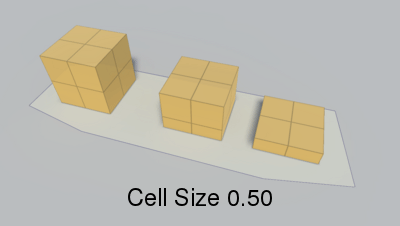
| float characterRadius = 1.5F |
Radius of the agent which will traverse the navmesh.
The navmesh will be eroded with this radius.

| float colliderRasterizeDetail = 10 |
Controls detail on rasterization of sphere and capsule colliders.
This controls the number of rows and columns on the generated meshes. A higher value does not necessarily increase quality of the mesh, but a lower value will often speed it up.
You should try to keep this value as low as possible without affecting the mesh quality since that will yield the fastest scan times.
| float contourMaxError = 2F |
Max distance from simplified edge to real edge.
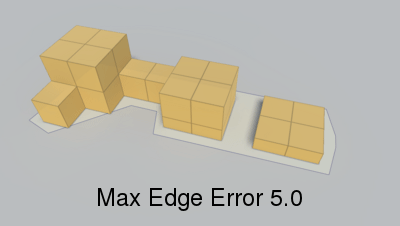
| bool dynamic = true |
Enables graph updating.
Uses more memory if enabled.
| int editorTileSize = 128 |
Size in voxels of a single tile.
This is the width of the tile.
A large tile size can be faster to initially scan (but beware of out of memory issues if you try with a too large tile size in a large world) smaller tile sizes are (much) faster to update.
Different tile sizes can affect the quality of paths. It is often good to split up huge open areas into several tiles for better quality paths, but too small tiles can lead to effects looking like invisible obstacles.
| Vector3 forcedBoundsCenter |
Center of the bounding box.
Scanning will only be done inside the bounding box
| Vector3 forcedBoundsSize = new Vector3(100, 40, 100) |
Size of the bounding box.
|
private |
| LayerMask mask = -1 |
Layer mask which filters which objects to include.
| float maxEdgeLength = 20 |
Longer edges will be subdivided.
Reducing this value can improve path quality since similarly sized polygons yield better paths than really large and really small next to each other
| float maxSlope = 30 |
Max slope in degrees the character can traverse.
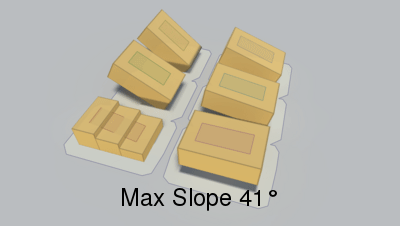
| float minRegionSize = 3 |
Minumum region size.
Small regions will be removed from the navmesh. Measured in square world units (square meters in most games).

If a region is adjacent to a tile border, it will not be removed even though it is small since the adjacent tile might join it to form a larger region.
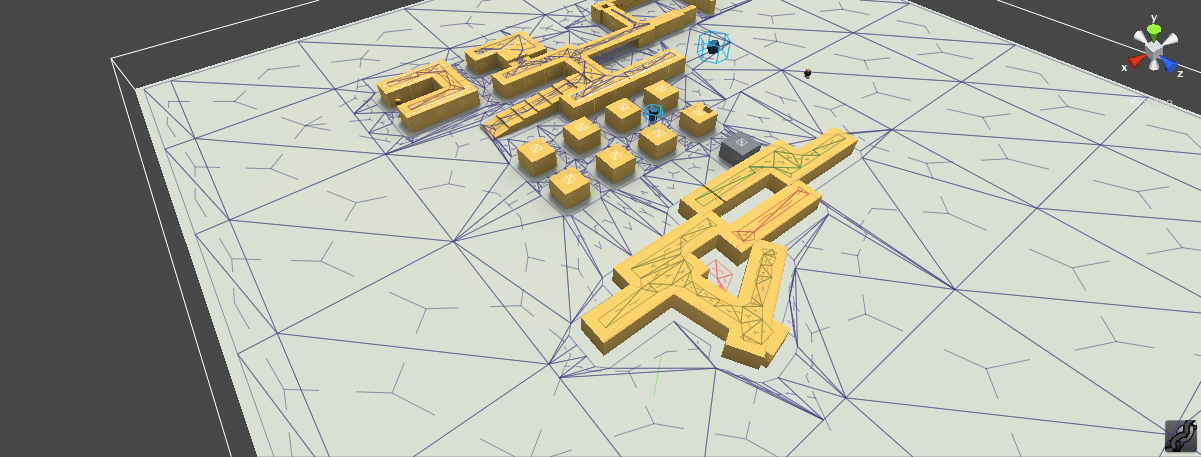

| bool nearestSearchOnlyXZ |
Perform nearest node searches in XZ space only.
| bool rasterizeColliders |
Use colliders to calculate the navmesh.
| bool rasterizeMeshes = true |
Use scene meshes to calculate the navmesh.
| bool rasterizeTerrain = true |
Include the Terrain in the scene.
| bool rasterizeTrees = true |
Rasterize tree colliders on terrains.
If the tree prefab has a collider, that collider will be rasterized. Otherwise a simple box collider will be used and the script will try to adjust it to the tree's scale, it might not do a very good job though so an attached collider is preferable.
| RelevantGraphSurfaceMode relevantGraphSurfaceMode = RelevantGraphSurfaceMode.DoNotRequire |
Require every region to have a RelevantGraphSurface component inside it.
A RelevantGraphSurface component placed in the scene specifies that the navmesh region it is inside should be included in the navmesh.
If this is set to OnlyForCompletelyInsideTile a navmesh region is included in the navmesh if it has a RelevantGraphSurface inside it, or if it is adjacent to a tile border. This can leave some small regions which you didn't want to have included because they are adjacent to tile borders, but it removes the need to place a component in every single tile, which can be tedious (see below).
If this is set to RequireForAll a navmesh region is included only if it has a RelevantGraphSurface inside it. Note that even though the navmesh looks continous between tiles, the tiles are computed individually and therefore you need a RelevantGraphSurface component for each region and for each tile.


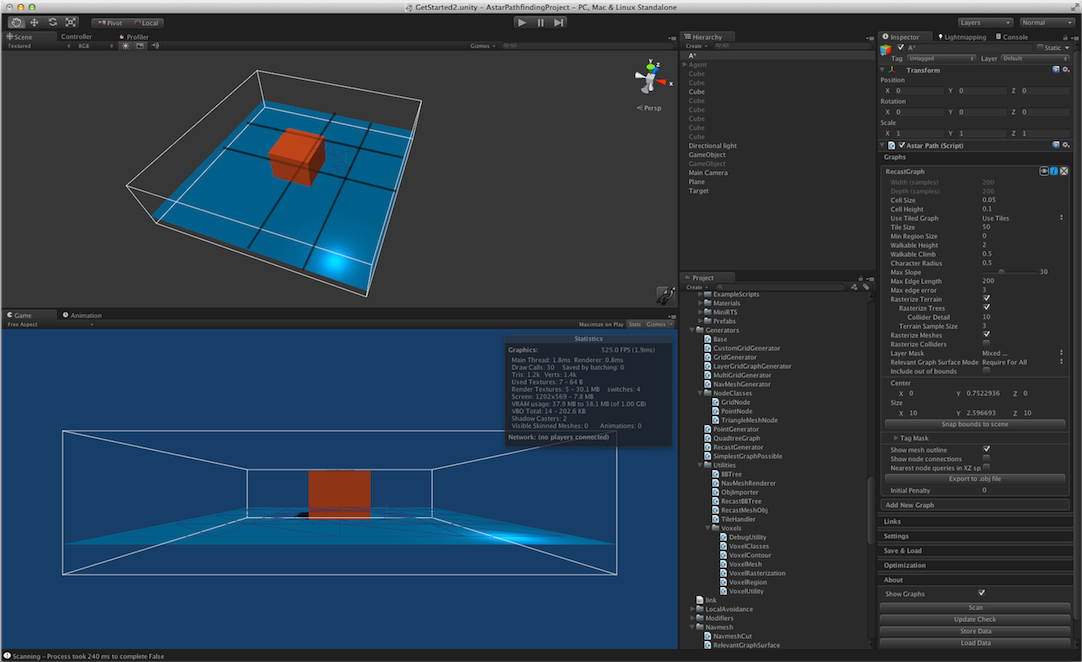
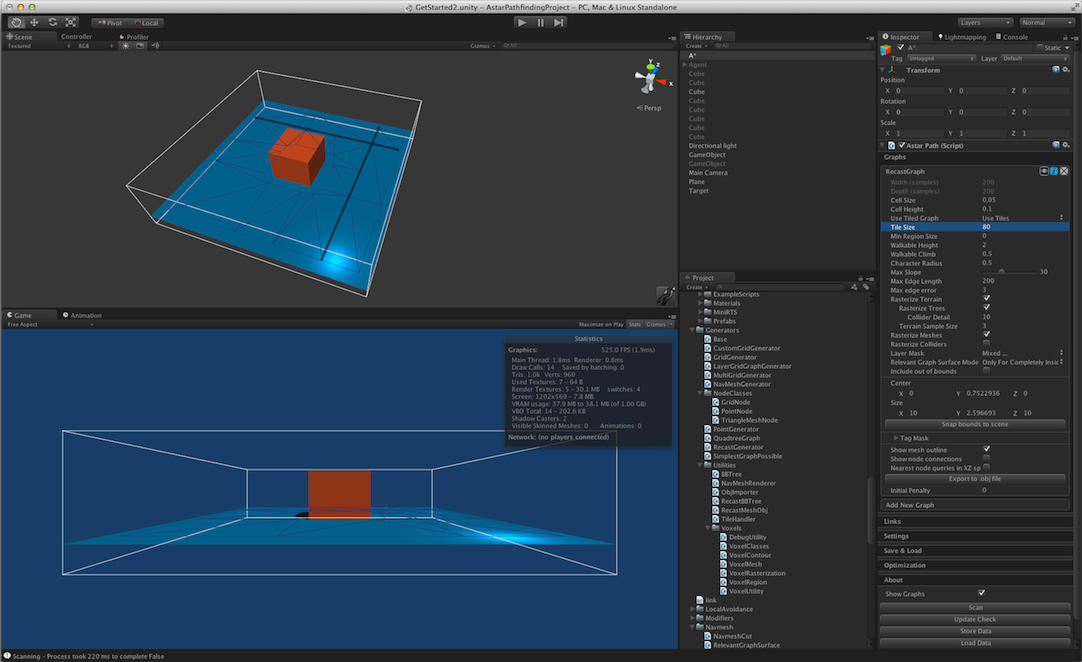
| bool scanEmptyGraph |
If true, scanning the graph will yield a completely empty graph.
Useful if you want to replace the graph with a custom navmesh for example
| bool showMeshOutline = true |
Show an outline of the polygons in the Unity Editor.
| bool showMeshSurface |
Show the surface of the navmesh.
| bool showNodeConnections |
Show the connections between the polygons in the Unity Editor.
|
private |
List of tiles that have been calculated in a graph update, but have not yet been added to the graph.
When updating the graph in a separate thread, large changes cannot be made directly to the graph as other scripts might use the graph data structures at the same time in another thread. So the tiles are calculated, but they are not yet connected to the existing tiles that will be done in UpdateAreaPost which runs in the Unity thread.
| List<string> tagMask = new List<string>() |
| int terrainSampleSize = 3 |
Controls how large the sample size for the terrain is.
A higher value is faster to scan but less accurate
| const int TileIndexMask = 0x7FFFF |
| const int TileIndexOffset = 12 |
|
private |
All tiles.
A tile can be got from a tile coordinate as tiles[x + z*tileXCount]
| int tileSizeX = 128 |
Size of a tile along the X axis in voxels.
| int tileSizeZ = 128 |
Size of a tile along the Z axis in voxels.
| int tileXCount |
Number of tiles along the X-axis.
| int tileZCount |
Number of tiles along the Z-axis.
| bool useTiles |
If true, divide the graph into tiles, otherwise use a single tile covering the whole graph.
| const int VertexIndexMask = 0xFFF |
| float walkableClimb = 0.5F |
Height the character can climb.

| float walkableHeight = 2F |
Character height.
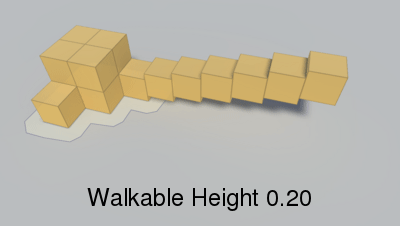
|
getprivate |
|
getprivate |
Convert character radius to a number of voxels.
|
get |
World bounds for the graph.
Defined as a bounds object with size forcedBoundsSize and centered at forcedBoundsCenter
|
getprivate |
Number of extra voxels on each side of a tile to ensure accurate navmeshes near the tile border.
The width of a tile is expanded by 2 times this value (1x to the left and 1x to the right)
|
getprivate |
| System.Action<NavmeshTile[]> OnRecalculatedTiles |
Called when tiles have been completely recalculated.
This is called after scanning the graph and after performing graph updates that completely recalculate tiles (not ones that simply modify e.g penalties). It is not called after NavmeshCut updates.